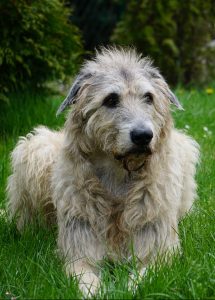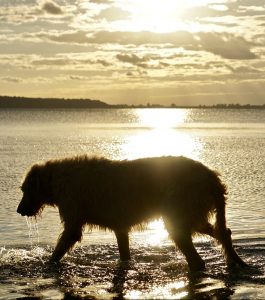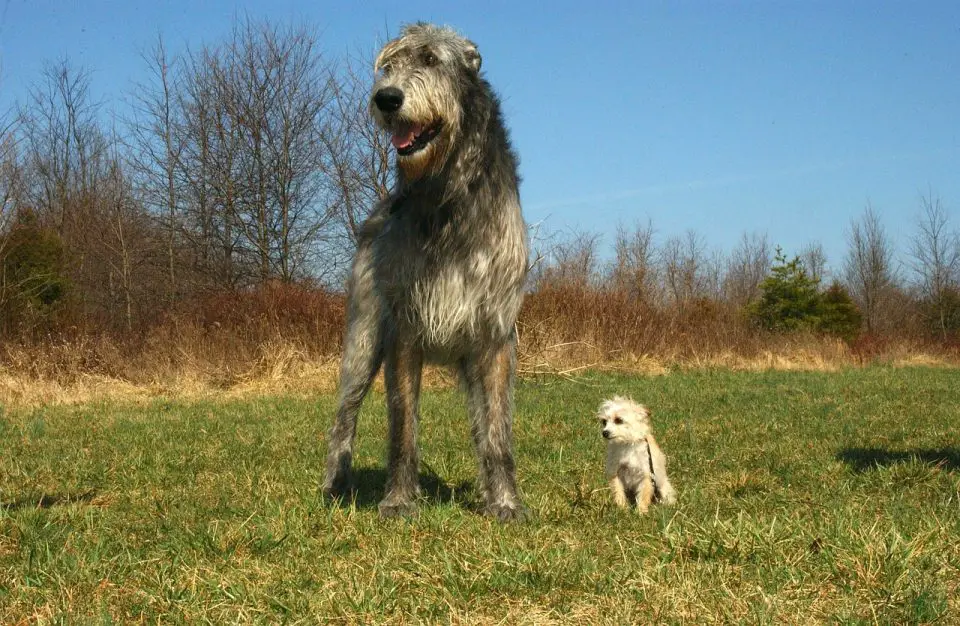Hi, my name’s Irena and I live on the beautiful island of Crete in the Mediterranean Sea with my crazy hound, Sherlock who I love to bits even though he does run me ragged on our walks.
I also have 3 adorable cats, Hamlet, Dimitris and Ebony, my lucky black cat. I don’t believe in any of this nonsense that black cats are unlucky.
Anyway, today I’m going to talk about how much Irish Wolfhounds shed.
Do Irish Wolfhounds Shed?
Do Irish Woldhounds shed? Yes, Irish Wolfhounds shed as do most dogs. They shed throughout the year, not seasonally, although their shedding isn’t excessive despite having double coats.
They never completely shed their undercoat. However, you will have to be prepared to do some sweeping up of hair throughout the year.
I’m continually doing this with my Sherlock. The amount of hair he loses is crazy. He should be bald, but he’s not!
Shedding and the Irish Wolfhound
The majority of dogs shed, and the Irish Wolfhound is no exception. Dogs have fur or hair to protect themselves from the elements.
When it stops growing, they naturally lose it through shedding and new hair grows. The amount shed depends on different factors like their breed and their health.
Some dogs shed twice a year, usually in the spring and the fall. Irish Wolfhounds, however, shed all year.
The Irish Wolfhound is the tallest dog out there, even taller than the Great Dane. The minimum height for males is 32 inches and for females, 30 inches.
However, males can reach 34 – 35 inches and weigh upwards of 140 pounds. That’s a lot more than I weigh!
If you stood them next to a donkey, they would be around the same height.
If they stand on just their back legs, which isn’t recommended, they can be as tall as 7 feet. However, despite their size, they are gentle giants.
They love children, but it’s better not to leave them alone with small children as accidents could happen because of their size.
Unfortunately, they only live for between 5 and 7 years. Larger dogs usually have a shorter lifespan than smaller dogs so keep this in mind when considering getting Irish Wolfhounds.
More About Irish Wolfhound
They are quiet indoors, but they are not suitable for apartment living partly because of their size and also because they aren’t good at going up and down stairs.
It doesn’t do much good for their joints. The best environment for them is a house with a big yard so that they can run about.
They need at least 40 minutes of exercise every day and they love to go for long walks.
With early socialization and training, they will be able to get on with other dogs you may have and even indoor cats.
However, outdoor cats and other animals are fair game. Remember to keep them on the lead when you take them for walks so that they don’t have the opportunity to chase anything.
Despite their size, Irish Wolfhounds don’t make good guard dogs. They are brave, but not aggressive. However, their size alone may deter possible intruders.
Irish Wolfhounds are generally a healthy breed, but there are a few diseases that some can suffer from.
Don’t worry though, not many dogs get these illnesses. The first is Willebrand’s disease where blood doesn’t clot properly.
Then there is Progressive Retinal Atrophy which is an eye disorder that can lead to blindness.
Megaesophagus is when the esophagus dilates and loses motility and cannot move food into the stomach.
Other problems can also occur such as canine hip dysplasia, heart disease, primarily heart failure, bone cancer, and bloat.
To lessen the occurrence of bloat don’t walk your Irish Wolfhounds 1 hour before a meal or 2 hours after.
The History of Irish Wolfhounds
Irish Wolfhounds have been around for many hundreds of years. They have been said to predate Christianity.
They were first around in the times of Kings and nobility. These dogs were bred in Ireland where they were considered to be brave and fierce.
Their original name was Cu which translates to Irish Hound. In battles, they were able to pull warriors off their horses.
The law in Ireland allowed only Kings and nobility to own Irish Wolfhounds. The number of dogs owned by each person was determined by their title.
For example, people of a lesser nobility were allowed to have 2 Irish Wolfhounds.
There is an Irish legend which says that folk hero, Finn Maccumhaill had 500! Just imagine trying to feed that many dogs each day.
 Irish Wolfhounds were a popular gift given by royalty and other important people. When given the dogs were often adorned with collars made from either silver or gold.
Irish Wolfhounds were a popular gift given by royalty and other important people. When given the dogs were often adorned with collars made from either silver or gold.
The earliest written record about Irish Wolfhounds is 391 A.D. when the Irish nobility gave 7 Irish Wolfhounds to the Roman Consul, Quintus Aurelius as a gift.
Irish Wolfhounds defended the property of their owners and their livestock against wolves.
Believe it or not, Irish Wolfhounds are totally capable of killing a wolf. They could also take on wild boar, deer, and the Irish Elk, which is enormous.
However, this actually led to their downfall as when there were no more of these animals around, they were surplus to requirements.
They almost became extinct, but a man called Captain George Augustus Graham decided to save Irish Wolfhounds and he started breeding them.
He founded the Irish Wolfhound Club in 1885. These dogs were recognized as a breed by the AKC in 1897 and by the English Kennel Club in 1925.
Now it isn’t difficult to adopt or buy these wonderful dogs.
What is an Irish Wolfhound’s Coat Like?
Irish Wolfhounds have rough and hard coats. The hair around the eyes and under the jaw is wiry and long.
They have double coats and the undercoat is soft and protected by the wiry topcoat. Their tails are heavily set, and their eyes are dark and have a gentle look to them.
Their ears are small and Greyhound-like. They can have different colored coats, including gray, brindle, red, black and fawn. They can even be completely white.
How Much do Irish Wolfhounds Shed?
You will be pleased to hear that Irish Wolfhounds are not big shedders and when you have a dog that size, it’s definitely a bonus.
Yes, you will have to do some sweeping up and cleaning of couches, but you won’t get too much hair, certainly not as much as with a dog like a Siberian Husky.
When do Irish Wolfhounds Shed the Most?
I have already said that Irish Wolfhounds shed all year and don’t shed seasonally.
However, there can still be times when they shed more and if this happens you should look into the cause.
They will shed more when they are shedding their puppy coats, but they may also shed more due to their diet or the state of their health.
You should feed your Irish Wolfhounds a quality dog food. These manufacturers ensure that the food has the right nutrients without having to give your dogs supplements.
Quality food will have a high percentage of protein that your dogs need. Cheaper dog food can contain empty fillers like wheat, corn or soy which don’t give them much nutritional value.
Perhaps your Irish Wolfhounds have allergies and you might have to experiment with different brands.
Other reasons for Irish Wolfhounds shedding excessively include parasites like fleas, ticks, and worms. Pregnancy can also cause hair loss as can lactating.
Perhaps your dogs have an infection or are taking medications that they are allergic to. Health problems like cancer or an infection can bring on hair loss.
In addition, they might have sunburn, or they could have come into contact with an irritating substance. If your Irish Wolfhounds do start shedding excessively the best thing to do is to go and see your vet.
How to Combat Irish Wolfhounds Shedding
 If you want to reduce shedding in your Irish Wolfhounds, the best thing to do is to set up a grooming schedule.
If you want to reduce shedding in your Irish Wolfhounds, the best thing to do is to set up a grooming schedule.
Irish Wolfhounds don’t need to be brushed every day, once or twice a week is enough. They don’t really need to be bathed more than once or twice a year unless they get particularly dirty or smelly.
Brush first with an undercoat rake and then use a wide-tooth comb. This will help to remove any knots and will detangle the hair.
Then go over their coats with a slicker brush. Always begin at the head and follow the direction of hair growth.
If you feel able, you can also trim their hair or if not take them to a groomer. Trim the hairs between the paw pads and around the genitals every 4 – 6 weeks.
Trimming the hair around their feet can also be done when needed, as well as around the neck, beard, and eyebrows.
If you are showing your Irish Wolfhounds, there are extra steps to take which will also help to reduce shedding.
Gently pluck and excess hair from their ears with your forefinger and thumb. Use thinning scissors to tidy up the hair on the feet and the sides of their neck, but don’t remove too much.
Irish Wolfhounds need to have a mane. It makes them stand out in a crowd. To finish, trim the hair underneath the stomach and at the base of the tail.
As well as reducing the amount of hair loss, grooming also gives you the opportunity to check for rashes, sores, and inflammation of the skin and the eyes.
Eyes should be clear with no discharge or redness. If you find anything untoward, it’s time for a visit to the vet.
Are Irish Wolfhounds Considered to be Hypoallergenic?
Irish Wolfhounds aren’t hypoallergenic. In fact, no breed of dog is completely hypoallergenic, although some breeds such as the Poodle and any of the hairless dogs may cause fewer allergy symptoms than others.
Many people think that allergies are caused by pet hair or fur, but this is incorrect. The thing that causes most allergies is a protein that is found in the saliva and urine of dogs.
This protein sticks to the dead and dry flakes of skin which are called dander.
There are dogs that are sold as being hypoallergenic because they don’t shed or shed very little.
Yes, the allergy-causing dander doesn’t get released into the air or onto the floor as much as with a shedding dog, but while you will have less dog hair with a non-shedding dog, there will still be dander and this goes for hairless dogs as well.
The problem with Irish Wolfhounds is that they are big dogs so they will shed more dander than a smaller dog.
If you have your heart set on Irish Wolfhounds, you may have to bathe them more often so that the dander gets washed away rather than going into the air.
Choose not to have carpets or shampoo your carpet often. Another good idea is to invest in an air purifier and vent filters which will help to reduce airborne pet allergies.
Do Some Irish Wolfhounds Shed More than Others?
No dog is just the same as another and you will get some variations in how much hair your Irish Wolfhounds will shed.
Yes, you may see some differences, but you should only really be concerned if one is shedding a lot more. It could be due to health issues so get your dog seen by the vet.
Perhaps one of your Wolfhounds is allergic to something like food or its’ collar or bedding. You will have to experiment with different food and accessories.
Final Thoughts: Do Irish Wolfhounds Shed?
 I think we can surmise that Irish Wolfhounds do shed, though not excessively.
I think we can surmise that Irish Wolfhounds do shed, though not excessively.
Still, they are not an ideal breed to have if you do have allergies.
To keep down the amount of hair shed, groom your dogs every week, keep a watchful eye on their health and feed them a high-quality diet.
It’s worth it to have such great loyal companions.
